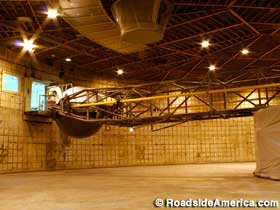
The Human Centrifuge (Closed)
Warminster, Pennsylvania
If you've seen movies about 1960s astronauts, you've seen the Human Centrifuge: a big sphere on the end of a giant metal pole, spinning in a circular room. Its job was to sling space travelers around to see how many "Gs" -- multiples of Gravity (body weight) -- a human could stand. Early astronauts needed to know about Gs because they were riding missiles into space, and taxpayers needed to see photos of men with their cheeks pulled behind their ears to know that their money was well spent.
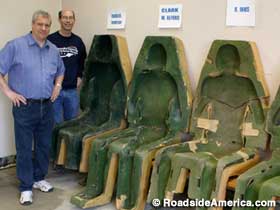
If you think it's like something you've ridden at an amusement park, you're wrong.
You'd expect the Human Centrifuge to be in Florida or Houston or Southern California, typical NASA spots. Nope. It's in an industrial park on a former secret Navy base in suburban Philadelphia.
"This is the most stable piece of land in all of North America," said Mike Maguire, president of the fledgling Johnsville Centrifuge and Science Museum. "98 percent bedrock. That's why the machine is here." The Human Centrifuge -- the largest ever built -- weighs 180 tons and could accelerate to 175 mph in just seven seconds. "The Navy built a smaller centrifuge in California," said Mike. "The first day they turned it on, it ripped itself right out of the ground."
Mike and museum VP Mark Calhoun are Human Centrifuge fans. They lead tours of the big machine and its bunker-like building, and want to transform what remains of the secret base into a sprawling aerospace museum. That includes the ejection tower next to the centrifuge, which was ridden by all of the Gemini astronauts. "They would strap guys to a seat, fill the seat with explosives, and blow them up," said Mike.
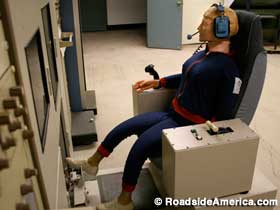
Listening to Mike and Mark, it quickly becomes clear that the scientists who ran the Human Centrifuge were the happiest, best-funded geeks of their day, and possibly just a little insane.
A tour of the centrifuge building includes the "Blue Shoe" water tank, the Contour Couches, and other creepy inventions that allowed human projectiles to travel at amazing speeds. The molded-to-your-body styrofoam couches were a luxury. Early volunteers were whipped around in padded baskets or just regular chairs ("Your body would deform to the shape of the seat," said Mike). One scientist brought his La-Z-Boy from home and rode the centrifuge nonstop for 24 hours, proving that it was possible to survive a super-quick trip to Mars in a constantly accelerating spaceship.
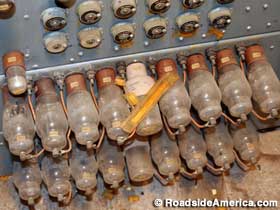
We followed Mike and Mark through the underground power tunnel, out to the generator substation (the centrifuge sucked enough electricity to cause local blackouts), past the animal cages (Ham the Astrochimp trained here), up to the flight deck, then further up to the "Blister" booth that hangs from the ceiling. A solitary operator would sit in it, spinning records on a turntable that sent coded directions to the centrifuge -- dip, turn, go faster! -- while the centrifuge whipped hurricane-force winds around him. Mark showed us the electronics room: banks of dusty vacuum tubes and patch cords, all still in place. The scientists never cleaned out their old equipment; they simply routed new cables around the old.
The more you see of the centrifuge, the more you realize how crazy it was: dangerously crude, wildly excessive, guaranteed to kill someone eventually. Mike and Mark want to tidy up the building, but we hope that they don't go too far. The Human Centrifuge wasn't built to be pretty; it was built to turn people into something resembling squashed laundry at the end of a spin cycle.
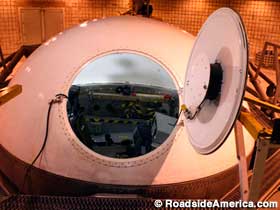
Although the centrifuge could produce up to 100 Gs, its operators soon realized that 40 Gs were enough to kill anyone (imagine yourself suddenly weighing 7,000 pounds). There was no need for a superhuman centrifuge, and the cost of running it eventually shut it down. It was too heavy to throw out, so the government simply abandoned it. According to Mike and Mark, the centrifuge was operational as recently as 2008. Then the building's landlord ripped out all of its copper wiring and sold it for scrap.
"We can still turn it on," said Mike. "We could run it with a battery if we could find a battery big enough." The 122-ton arm of the centrifuge is so well-balanced that you can push it with one hand. But Mike and Mark realize that the Human Centrifuge is still "a dangerous machine" and leave it switched off. Tour-goers, however, can sit in the ball and pose for snapshots, and Mike and Mark plan to sell "I went to 1 G in the Centrifuge" t-shirts.





